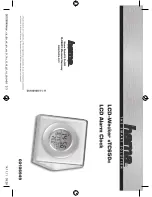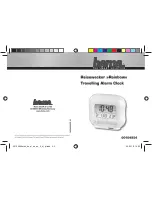
5
Tamper switch
General Maintenance
To keep your Smoke/CO detector in good working order, please follow these
simple steps. Verify alarm siren, LED lights, and battery operation by pushing the
test buttons at least once a week. Remove the device from the mounting bracket
and vacuum the detector cover and vents with a soft brush attachment once a
month to remove dust and dirt. Reinstall immediately after cleaning and then test
using the tests button.
Never attempt to disassemble the unit or clean inside of it as this will void your
warranty. Never use detergents or solvents to clean the unit. When household
cleaning supplies or similar contaminates are used, the area must be well
ventilated. The following substances can damage the sensors and may cause
false reading: methane, propane, isobutene, isopropanol, ethyl acetate,
hydrogen sulfide, sulfide dioxides, alcohol base products, paints, thinner,
solvents, adhesives, hair spray, after shave, pertume, and some cleaning agents.
Do not paint the detector. Paint will seal the vents and interfere with its ability to
detect smoke and CO. Move the detector prior to performing any of the following:
staining or stripping wood floors or furniture, painting, wall papering, using
adhesives. Store the detector in a plastic bag during any of the above projects to
help protect the sensors from damage. Make sure to reinstall the detector once
done so as to assure continuous protection.
If CO alarm activates
Actuation of your CO alarm indicates the presence of carbon monoxide (CO)
which can kill you. If CO is detected, follow these steps. Thoroughly familiarize
yourself with these items and review them with all of your family members.
WARNING!!
Actuation of your CO detector indicates the presence of carbon monoxide (CO)
which can KILL YOU. If alarm signal sounds:
1. Operate reset/silence button
2. Call your emergency services (Telephone Number) [fire department or 911];
3. Immediately move to fresh air – outdoors or by an open door/window. Do a
head count to check that all persons are accounted for. Do not reenter the
premises nor move away from the open door/window until the emergency
services responders have arrived, the premises have been aired out, and your
alarm remains in its normal condition.
4. After following steps 1 – 3, if your alarm reactivates within a 24 hour period,
repeat steps 1 – 3 and call a qualified appliance technician (Telephone Number)
to investigate for sources of CO from fuel burning equipment and appliances,
and inspect for proper operation of this equipment. If problems are identified
during this inspection have the equipment serviced immediately. Note any
combustion equipment not inspected by the technician and consult the
manufacturers’ instructions, or contact the manufacturers directly, for more
information about CO safety and this equipment. Make sure that motor vehicles
are not, and have not been, operating in an attached garage or adjacent to the
residence.
When the batteries are low and need to be replaced,
the device will beep and the yellow LED light will flash once every 50 seconds.
This warning should last for up to 30 days, but please replace the battery asap
before battery power is completely exhausted.
When disposing of the detector, Please refer to
section to deactivate your detector.
Figure 11:
Tamper switch location
Actions to take after the problem being corrected
Once the problem about the CO gas presence in the premises has been
corrected, the alarm of the CO alarm unit should be off. After waiting for 10
minutes, push the Test button to test the CO alarm unit so that you can make sure
that it is working properly again.
Technical information for CO alarm
According to the UL2034 has already established the carbon monoxide
concentrations and exposure time standards for the alarms, which is specified
below:
UL2034:
At 70ppm, the unit must alarm within 60-240 minutes
At 150ppm, the unit must alarm within 10-50 minutes
At 400ppm, the unit must alarm within 4-15 minutes
(Note: This section is for model SCAZB-141, SCAZB-143)
If smokes alarm activates
Never ignore the sound of the alarm. Check for signs of fire or smoke throughout
the residence. If a fire is discovered, follow the steps list below. Thoroughly
familiarize yourself with these items and review them with all of your family
members.
The detector is not to be located within 5 feet (1.5m) of any cooking appliance.
In damp or very humid areas, or near bathrooms with showers. Moisture in
humid air can enter the sensing chamber, then turns into droplets upon cooling,
which can cause nuisance alarms. Install smoke detectors at least 10 feet (3
meters) away from bathrooms.
In very cold or very hot areas, including unheated buildings or outdoor rooms.
If the temperature goes above or below the operating range of smoke detector,
it will not work properly. The temperature range for your smoke detector is 40
to 100 F (4.4 C to 37.8 C).
In very dusty or dirty areas, dirt and dust can build up on the detector’s sensing
chamber, to make it overly sensitive. Additionally, dust or dirt can block
openings to the sensing chamber and keep the detector from sensing smoke.
Near fresh air vents or very drafty areas like air conditioners, heaters or fans,
fresh air vents and drafts can drive smoke away from smoke detectors.
Dead air spaces are often at the top of a peaked roof, or in the corners between
ceilings and walls. Dead air may prevent smoke from reaching a detector. See
Figures 5 and 6 for recommended mounting locations.
In insect-infested areas. If insects enter a detector’s sensing chamber, they may
cause a nuisance alarm. Where bugs are a problem, get rid of them before
putting up a detector.
Near fluorescent lights, electrical “noise” from fluorescent lights may cause
nuisance alarms. Install smoke detectors at least 5 feet (1.5 meters) from such
lights.
Your smoke detector is not to be used with smoke alarm guards.
CO TROUBLE WARNING:
The CO trouble pattern is one (1) siren beep with two (2)
corresponding flashes of the yellow LED light every 50 seconds. This pattern
indicates the unit needs to be replaced.
(Note: This section is for model SCAZB-141, SCAZB-143)
SMOKE TROUBLE WARNING:
The Smoke trouble pattern is three (3) sirens beep
with one (1) corresponding flashes of the yellow LED light every 50 seconds. This
pattern indicates the unit needs to be replaced.
SMOKE CLEAN ME WARNING:
The Smoke high sensitivity pattern is two (2) sirens
beep with two (2) corresponding flashes of the yellow LED light every 50 seconds.
This pattern indicates that the unit should be maintained or cleaned. Please refer
to
GENERAL MAINTENANCE
section.
SMOKE LOW SENSITIVITY WARNING:
The Smoke high sensitivity pattern is two
(2) sirens beep with one (1) corresponding flashes of the yellow LED light every 50
seconds. This pattern indicates the unit needs to be replaced.
HUSH FEATURE:
The hush feature can temporarily quiet the siren for one hour,
and the LED still flashes according to correspond warning signal. You can
silent/restore any warning signal by pressing the Test/Silence button on the
warning signal.
(Note: The Low battery warning can’t be silenced)
END OF PRODUCT LIFE WARNING:
The device will one (1) beep with four (4)
corresponding flashes of the yellow LED light every fifty (50) seconds. This
indicates that the detector must be replaced and deactivated immediately. The
end-of-life is set ten-year when the user places the unit into service.
WARNING:
When disposing of the detector, Please refer to DEACTIVATION OF
DETECTOR section to deactivate your detector.
TAMPER ALARM:
When the bracket is uninstalled, the tamper switch is opened,
the tamper alarm will sound, the tamper switch location as shown in Figure 11,
The tamper alarm pattern is two (2) long alarm sirens with two (2) corresponding
flashes of the yellow LED.
WARNING:
The tamper alarm is silenced for 5 minutes after energizing.
• Smoke alarms may not awaken all sleeping individuals, and that it is the
responsibility of individuals in the household that are capable of assisting others
to provide assistance to those who may not be awakened by the alarm sound,
or to those who may be incapable of safely evacuating the area unassisted.
Leave immediately using one of your pre-planned escape routes. Every second
counts .Do not get dressed or pick up valuables.
• Before opening inside doors, look for smoke seeping in around edges. Feel the
door with the back of your hand. If the door is hot, try to use another exit. If you
feel it is safe, open the door very slowly but be prepared to close it should
smoke rush in.
• If your escape route requires you to go through smoke, crawl low and under
the smoke where the air is clearer.
• Go to your predetermined meeting place. When two people have arrived, one
should leave to call 911 from a neighbor’s home. The other should stay to
perform a head count.
• Do not reenter the premises under any circumstances until the fire department
gives you permission.
RESETTING ZIGBEE NETWORK:
Resetting is needed if you want to connect your
Smoke/CO detector to another gateway or if you need to perform a factory reset
to eliminate abnormal behavior.
Please follow these steps to reset the zigbee network for your Smoke/CO
detector.
1. Push the Test/Silence button, shown in Figure 10, rapidly five times.
The Smoke/CO detector will sound a siren beep on each press.
2. The green LED will light for about a second when the reset is complete.
3. The Smoke/CO detector will start searching (up to 15 minutes) for a
Zigbee network to join.
(d) Make sure that the Zigbee network is open for joining devices and will accept
the Smoke/CO detector.
(e) While the Smoke/CO detector is searching for a Zigbee network to join, the
green LED is flashing.
(f) When the green LED stops flashing, the Smoke/CO detector has successfully
joined the Zigbee network.
























